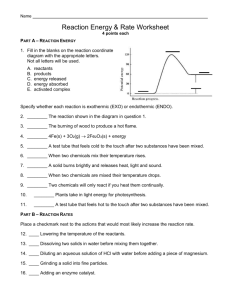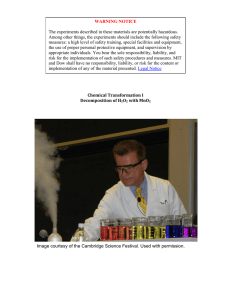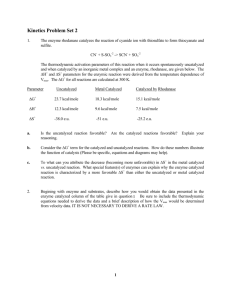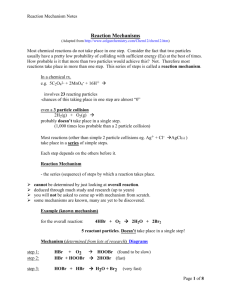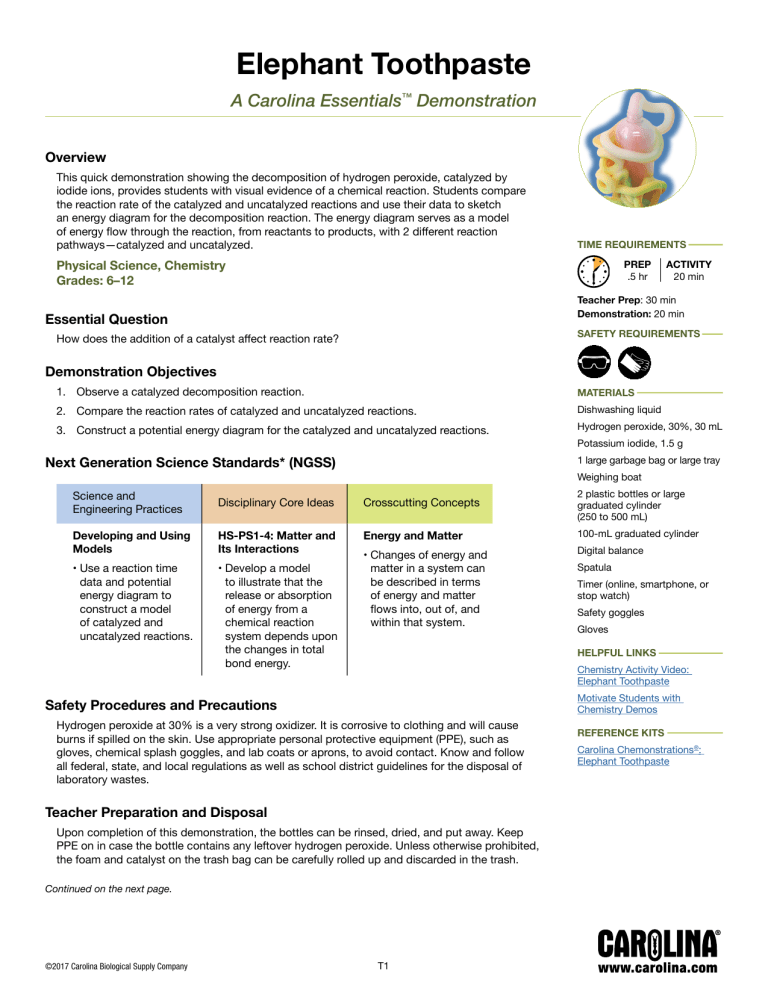
Elephant Toothpaste A Carolina Essentials™ Demonstration Overview This quick demonstration showing the decomposition of hydrogen peroxide, catalyzed by iodide ions, provides students with visual evidence of a chemical reaction. Students compare the reaction rate of the catalyzed and uncatalyzed reactions and use their data to sketch an energy diagram for the decomposition reaction. The energy diagram serves as a model of energy flow through the reaction, from reactants to products, with 2 different reaction pathways—catalyzed and uncatalyzed. TIME REQUIREMENTS Physical Science, Chemistry Grades: 6–12 PREP .5 hr ACTIVITY 20 min Teacher Prep: 30 min Demonstration: 20 min Essential Question SAFETY REQUIREMENTS How does the addition of a catalyst affect reaction rate? Demonstration Objectives 1. Observe a catalyzed decomposition reaction. MATERIALS 2. Compare the reaction rates of catalyzed and uncatalyzed reactions. Dishwashing liquid 3. Construct a potential energy diagram for the catalyzed and uncatalyzed reactions. Hydrogen peroxide, 30%, 30 mL Potassium iodide, 1.5 g Next Generation Science Standards* (NGSS) 1 large garbage bag or large tray Weighing boat Science and Engineering Practices Disciplinary Core Ideas Crosscutting Concepts 2 plastic bottles or large graduated cylinder (250 to 500 mL) Developing and Using Models HS-PS1-4: Matter and Its Interactions Energy and Matter 100-mL graduated cylinder Digital balance • Use a reaction time data and potential energy diagram to construct a model of catalyzed and uncatalyzed reactions. • Develop a model to illustrate that the release or absorption of energy from a chemical reaction system depends upon the changes in total bond energy. • Changes of energy and matter in a system can be described in terms of energy and matter flows into, out of, and within that system. Timer (online, smartphone, or stop watch) Safety goggles Gloves HELPFUL LINKS Chemistry Activity Video: Elephant Toothpaste Motivate Students with Chemistry Demos Safety Procedures and Precautions Hydrogen peroxide at 30% is a very strong oxidizer. It is corrosive to clothing and will cause burns if spilled on the skin. Use appropriate personal protective equipment (PPE), such as gloves, chemical splash goggles, and lab coats or aprons, to avoid contact. Know and follow all federal, state, and local regulations as well as school district guidelines for the disposal of laboratory wastes. Teacher Preparation and Disposal Upon completion of this demonstration, the bottles can be rinsed, dried, and put away. Keep PPE on in case the bottle contains any leftover hydrogen peroxide. Unless otherwise prohibited, the foam and catalyst on the trash bag can be carefully rolled up and discarded in the trash. Continued on the next page. ©2017 Carolina Biological Supply Company Spatula T1 REFERENCE KITS Carolina Chemonstrations®: Elephant Toothpaste Elephant Toothpaste A Carolina Essentials™ Demonstration Teacher Procedure Teacher Preparation and Tips 1. Put on gloves and safety goggles. 2. Crush any lumps of potassium iodide (KI) into fine crystals with a spatula, and then weigh 1.5 g of it onto a weighing boat or filter paper. 3. Lay a large garbage bag flat on a desk, table, or lab bench to protect the demonstration area. A large tray can also be used for this purpose. Make sure the bottles are identical and that students understand both bottles are getting the same amount of the same chemicals. The only difference is the addition of the catalyst. 4. Prepare both bottles or cylinders at the same time. Label one “Uncatalyzed” and the other “Catalyzed.” 5. Place the plastic bottles or large graduated cylinders in the middle of the demonstration area. 6. Measure 15 mL of 30% hydrogen peroxide and pour it into the bottle or cylinder. Repeat for the second bottle or cylinder. 7. Add 25 drops of dishwashing liquid to the hydrogen peroxide in both bottles or cylinders. Dawn dishwashing liquid produces a high volume of bubbles. 8. Swirl the bottles or cylinders to mix the liquid soap and peroxide. Announce for students to get ready to time the reactions. You may want to assign individual students, 2 students per group, or split the room in half so both reactions are timed. 9. Prepare students to begin timing the reactions as soon as the KI is added to the bottle or cylinder labeled “Catalyzed.” 10. Quickly add the KI crystals to the bottle or cylinder labeled “Catalyzed” and begin timing. Begin timing as soon as the KI is added. 11. Observe the oxygen gas as it forms bubbles in the soap, creating a plume of foam that is quickly expelled. Announce to students when to stop timing the catalyzed reaction. 12. Stop timing the catalyzed reaction when the foam stops flowing out of the container. Continue timing the uncatalyzed reaction. 13. Direct students to answer the demonstration analysis questions. Check for evidence of a reaction in the uncatalyzed container every 5 minutes until students finish. Stop timing if or when a noticeable volume of bubbles is produced in the uncatalyzed container. Check the uncatalyzed reaction periodically for any evidence of bubbles. Data and Observations Reaction Time (s) Observations Uncatalyzed Reaction. Will vary with temperature May see small bubbles Catalyzed Reaction Instantaneous—runs for about 2 minutes Large amounts of foam spew out of the bottle Continued on the next page. ©2017 Carolina Biological Supply Company T2 Elephant Toothpaste A Carolina Essentials™ Demonstration Analysis and Discussion 1. What evidence indicates that a reaction took place? Bubbles were produced. 2. Why was dishwashing detergent added to the hydrogen peroxide? The detergent traps the oxygen bubbles, making a foam that allows the bubbles to be more visible and last longer. 3. Why was the solid potassium iodide added to one of the bottles? It serves as a catalyst. 4. Compare the times for the 2 reactions. Using the time data, write a statement explaining what catalysis is. When a reaction time is relatively slow and needs to be faster, a catalyst can be added. A catalyzed reaction has a shorter reaction time because the addition of a catalyst lowers activation energy. See the explanation of the reaction mechanism below. Hydrogen peroxide (H2O2 ) is stable for at least a year if stored in an airtight opaque container at room temperature. Common in first aid kits, a 3% H2O2 solution can be applied to minor cuts and abrasions. When the solution contacts tissue and blood, it rapidly decomposes into water (H2O) and oxygen gas (O2 ) . 2H2O2 ( l ) →2H2O(l) + O2 ( g ) The oxygen gas creates a foam that lifts and washes contaminants out of the wound. This rapid decomposition can only happen in the presence of a catalyst. In the human body that catalyst is catalase, a biological catalyst in blood and tissue. Catalase can lower the activation energy from 75 kJ/mol to about 8 kJ/mol. In this demonstration, solid potassium iodide (KI) dissolves in aqueous H2O2 , forming an aqueous iodide ion (I-) and catalyzing the reaction of aqueous H2O2. The steps of the reaction mechanism are as follows: Step 1 H2O2(aq) + I- (aq)→H2O(l) + IO- (aq) Step 2 IO (aq) + H2 O2 (aq)→H2O(l) + O2(g) + I (aq) _________________________________________ Fast Reaction 2H2O2(aq)→2H2O(l) + O2(g) Overall Net Reaction Slow Reaction - - ∆H= -196.1 kJ/mol 5. The decomposition of hydrogen peroxide is an exothermic reaction. If the uncatalyzed activation energy is about 75 kJ/mol and ∆H= -196.1 kJ/mol, sketch a potential energy diagram for the catalyzed and uncatalyzed reactions. Label the reactions, axes, reactants, products, and activation energy for both reactions. energy 75 kj/mol activation energy activation energy Reactants -196.1 kj/mol Products uncatalyzed reaction catalyzed reaction time Continued on the next page. ©2017 Carolina Biological Supply Company T3 Elephant Toothpaste A Carolina Essentials™ Demonstration TEACHER NOTES *Next Generation Science Standards® is a registered trademark of Achieve. Neither Achieve nor the lead states and partners that developed the Next Generation Science Standards were involved in the production of this product, and do not endorse it. ©2017 Carolina Biological Supply Company T4
